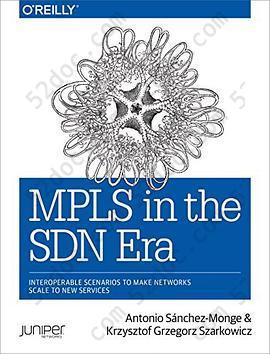注重体验与质量的电子书资源下载网站
分类于: 互联网 人工智能
简介

MPLS in the SDN Era: Interoperable Scenarios to Make Networks Scale to New Services 豆 0.0分
资源最后更新于 2020-08-23 08:20:12
作者:Antonio Sanchez Monge
出版社:O'Reilly Media
出版日期:2016-01
ISBN:9781491905456
文件格式: pdf
标签: 网络
简介· · · · · ·
How can you make multivendor services work smoothly on today’s complex networks? This practical book shows you how to deploy a large portfolio of multivendor Multiprotocol Label Switching (MPLS) services on networks, down to the configuration level. You’ll learn where Juniper Network's Junos, Cisco's IOS XR, and OpenContrail, interoperate and where they don’t.
Two network and c...
目录
Preface xv
1 Introduction to MPLS and SDN 1
The Internet 1
ISP Example Topology 5
Router Types in a Service Provider 6
BGP Configuration 8
BGP Route Signaling and Redundancy 13
Packet Forwarding in a BGP-Less Core 18
MPLS 19
MPLS in Action 20
The MPLS Header 22
MPLS Configuration and Forwarding Plane 23
Forwarding Equivalence Class 30
Again, What Is MPLS? 30
OpenFlow 31
OpenFlow—Flow-Based Forwarding 32
OpenFlow—Openness and P4 33
SDN 34
Separation of the Control and Forwarding Planes 35
SDN and the Protocols 36
The SDN Era 37
SDN-Era Use Cases 38
2 The Four MPLS Builders 43
LDP 44
LDP Discovery and LDP Sessions 45
LDP Label Mapping 48
LDP and Equal-Cost Multipath 56
LDP Implementation Details 60
LDP Inter-Area 64
Protecting LDP Networks from Traffic Blackholing 65
RSVP-TE 68
RSVP-TE LSP Fundamentals 70
RSVP-TE in Action 78
RSVP-Constrained Paths and ECMP 85
Inter-Area RSVP-TE LSPs 90
RSVP Auto Tunnel 91
IGP and SPRING 92
SPRING in Action 94
SPRING Concepts 99
SPRING Adjacency Segments 102
A Comparison of LDP, RSVP-TE, and SPRING 103
BGP-Labeled Unicast 104
IGP-Free Large-Scale Data Centers 105
BGP-LU Configuration 108
Service Configuration in an IGP-Less Topology 114
BGP-LU—Signaling and Forwarding Plane 119
BGP-LU—SPRING Extensions 121
3 Layer 3 Unicast MPLS Services 125
6PE: IPv6 Transport in an IPv4/MPLS Core 126
6PE—Backbone Configuration at the PEs 127
6PE—RR Configuration 128
6PE—Access Configuration at the PEs 129
6PE—Signaling 131
6PE—Forwarding Plane 133
BGP/MPLS IP Virtual Private Networks 137
Attachment Circuits and Access Virtualization 138
L3VPN in a Nutshell 140
L3VPN—Signaling 141
L3VPN—Forwarding Plane 146
L3VPN—Backbone Configuration at the PEs 148
L3VPN—RR Configuration 149
L3VPN—VRF Configuration at the PEs 150
L3VPN—Routing Tables in Junos 154
L3VPN—Service Label Allocation 156
L3VPN—Topologies 157
L3VPN—Loop Avoidance 163
Internet Access from a VRF 165
Route Target Constraint 166
RTC—Signaling 166
RTC—RR Configuration 168
RTC—PE Configuration 169
Coupling MPLS Services to Transport Planes 170
Configuring Several Loopbacks in the Default Instance 170
Signaling LSPs to Different Loopback Addresses 171
Changing the Service Routes’ BGP Next Hop 175
4 Internet Multicast Over MPLS 177
IP Multicast 178
IP Multicast Protocols 179
IP Multicast Modes 180
Classic Internet Multicast 181
Starting Multicast Sources and Receivers 181
Signaling the Multicast Tree 183
Classic Internet Multicast—Connecting Multicast Islands Across the Core 188
Signaling Join State Between Remote PEs 191
Carrier IP Multicast Flavors 191
Direct Inter-PE Model—PE-to-PE PIM Adjacencies over Unicast
IP Tunnels 192
Direct Inter-PE Model—PE-to-PE PIM Adjacencies over Multicast IP
Tunnels 194
Direct Inter-PE Model—PE-PE PIM Adjacencies over MPLS Label-
Switched Paths 197
Beyond the Direct Inter-PE Model—Not Establishing PE-PE PIM
Adjacencies 198
Internet Multicast over MPLS with In-Band Multipoint LDP Signaling 199
Multipoint LDP 200
In-Band Signaling 201
Life of a C-Multicast Packet in an mLDP P2MP LSP 208
CE Multihoming 213
mLDP In-Band and PIM ASM 216
Other Internet Multicast over MPLS Flavors 217
5 Multicast VPN 219
BGP Multicast VPN with mLDP Transport 220
MVPN Address Family 220
Configuring BGP MVPN 224
MVPN Site AD 226
Signaling C-Multicast (S, G) Join State with BGP 228
Signaling Provider Tunnels—BGP and the PMSI Attribute 234
Signaling Provider Tunnels—Multipoint LDP for Transport 241
BGP Multicast VPN with RSVP-TE P2MP Transport 247
Advertising the Inclusive PMSI—RSVP-TE P2MP 248
Advertising Selective PMSIs—RSVP-TE P2MP 250
Signaling P- Tunnels with RSVP-TE P2MP 252
BGP Multicast VPN with Ingress Replication 257
Inclusive PMSI—IR 258
Selective PMSI—IR 259
BGP Multicast VPN with Other P- Tunnel Flavors 260
CE Multihoming in BGP Multicast VPN 260
Egress PE Redundancy 260
Ingress PE Redundancy 260
Choosing the Best RD Scheme 262
BGP Multicast VPN with C-PIM ASM 263
ASM Mode 263
C-Rendezvous Point—PE and CE Configuration 266
C-Multicast Signaling—ASM Mode with C-RP at the PEs 267
Noncongruent C-Unicast and C-Multicast 268
6 Point-to-Point Layer 2 VPNs 271
L2VPN in a Nutshell 271
L2VPN Use Cases 272
L2VPN Topological Classification 275
L2VPN Signaling and Transport 276
P2P L2VPN—Varied Access Technologies 277
L2VPN Flavors Covered in This Book 278
VPWS Signaled with BGP 280
BGP L2VPN Address Family 280
BGP VPWS Configuration at the PEs 281
BGP VPWS Signaling 284
L2VPN Forwarding Plane 289
BGP VPWS—CE Multihoming to Several PEs 291
Ethernet OAM (802 3ah, 802 1ag) 297
BGP VPWS—VLAN Tag Multiplexing 298
BGP VPWS—VLAN Tag Translation and Manipulation 300
BGP VPWS—PW Head-End (PWHE) 303
BGP VPWS—Load Balancing 306
VPWS Signaled with LDP 307
LDP VPWS Configuration at the PEs 308
LDP VPWS Signaling and Forwarding Planes 309
LDP VPWS—CE Multihoming and PW Redundancy 310
LDP VPWS—VLAN Tag Multiplexing 312
LDP VPWS—VLAN Tag Translation and Manipulation 314
LDP VPWS—PWHE 314
LDP VPWS—FAT 315
7 Virtual Private LAN Service 317
Introduction to VPLS 317
VPLS Signaled with BGP 320
BGP VPLS Configuration 320
BGP VPLS Signaling 322
BGP VPLS—Efficient BUM Replication 324
VPLS Signaled with LDP 326
LDP VPLS Configuration 326
LDP VPLS Signaling 328
LDP VPLS—Autodiscovery via BGP 330
VLANs and Learning Domains in VPLS 332
VPLS in default VLAN mode 333
Junos VPLS Instances—Normalized VLAN Mode 334
Junos VPLS Instances—VLAN-Free Mode 335
Junos VPLS Instances—VLAN-Aware Mode 336
Junos Virtual Switches 336
Integrated Routing and Bridging in VPLS 337
IRB Configuration in Junos VPLS Instances 338
IRB Configuration in Junos Virtual Switches 339
IRB Configuration in IOS XR 339
VPLS—IRB Redundancy and Traffic Tromboning 340
Hierarchical VPLS 343
H-VPLS Model with LDP Signaling 344
H-VPLS Models with BGP for Autodiscovery and Signaling 345
8 Ethernet VPN 347
EVPN with MPLS Transport 347
EVPN Versus VPLS 347
EVPN Implementations 348
EVPN—This Book’s Topology 349
BGP EVPN Address Family 349
EVPN with MPLS Transport—Junos Configuration 350
EVPN MPLS—Inclusive Tunnel and Autodiscovery 351
EVPN with MPLS Transport—Advertising MACs 353
EVPN with MPLS Transport—Intra-VLAN Bridging 354
EVPN with MPLS Transport—Inter-VLAN Forwarding 356
EVPN with MPLS Transport—All-Active Multihoming 362
Ethernet VPN with VXLAN Transport 370
Data Center Challenges 370
VXLAN 371
EVPN with VXLAN Transport—Motivation 373
EVPN with VXLAN Transport—Forwarding Plane 374
EVPN with VXLAN Transport—Junos Configuration 375
EVPN with VXLAN Transport—Signaling 376
Provider Backbone Bridging EVPN 377
Introduction to PBB 377
PBB EVPN in a Nutshell 379
PBB EVPN Implementations 379
PBB EVPN in Action 380
PBB EVPN Configuration 384
PBB EVPN Signaling 387
9 Inter-Domain MPLS Services 389
Inter-Domain Architectures 389
This Chapter’s Example Topology 390
Inter-AS Flavors 391
Inter-AS Option A 393
Inter-AS Option B 395
Inter-AS Option B—Signaling and Forwarding 395
Inter-AS Option B—Junos Configuration 400
Inter-AS Option B—IOS XR Configuration 403
Inter-AS Option B with Local VRF 404
Inter-AS Option C 407
BGP Sessions in Inter-AS Option C 408
Inter-AS Option C—Signaling and Forwarding 409
Inter-AS Option C—Configuration 412
Carrier Supporting Carrier 417
Inter-Domain RSVP-TE LSPs 419
10 Underlay and Overlay Architectures 421
Overlays and Underlays 422
Overlay and Underlay Are Relative Concepts 422
Other Fundamental Concepts 423
Multiforwarder Network Devices 423
Single-Chassis Network Devices—Forwarding Plane 424
Single-Chassis Network Devices—Control Plane 425
Multichassis Network Devices 431
Legacy Data Center Networking 431
The Challenges of L2 Bridged Networks 431
Underlays in Modern Data Centers 433
Overlays in Modern Data Centers 434
Data Center Underlays—Fabrics 436
IP Fabrics—Forwarding Plane 437
IP Fabrics with Distributed-Only Control Plane 441
IP Fabrics with Hybrid Control Plane 442
Network Virtualization Overlay 443
Compute Controllers 445
Virtual Network Controllers 446
NVO—Transport of Control Packets 447
NVO—Agents 447
11 Network Virtualization Overlays 449
OpenContrail in a Nutshell 450
OpenContrail Controllers 451
Compute, Gateway, and Service Nodes 452
Case Study: A Private Cloud 454
vRouter-VM Link Addressing 457
Initializing vNICs—XMPP as a DHCP-Like Protocol 458
Interconnecting VMs—XMPP as a BGP-Like Protocol 462
Interconnecting Subscribers to Cloud VMs 466
Communication Between Virtual Networks 469
Network Virtualization Overlay: L2_L3 Mode 470
VXLAN Refresher 470
Intrasubnet (L2) and Intersubnet (L3) Traffic 472
Interconnecting VMs—IntraSubnet Traffic with VXLAN 473
vRouter and Gateway Nodes—L2_L3 Mode 476
Integrating Legacy L2 World into the NVO 478
L2 Gateways and OVSDB 479
ToR Service Nodes 480
Binding a Bare-Metal Server to the Overlay 481
MAC Learning with OVSDB 485
Bare-Metal Servers and OVSDB—the Forwarding Plane 487
12 Network Function Virtualization 489
NFV in the Software-Defined Networking Era 490
Virtual or Physical? 490
Applicability of NFV to Service Providers 492
NFV Practical Use Case 494
NFV Forwarding Plane 496
NFV—VRF Layout Models 498
Legacy VRF Layout—Transit VN Model 500
Modern VRF Layout—Two-VN Model 501
NFV—Long Version of the Life of a Packet 504
NFV Control Plane 506
NFV Scaling and Redundancy 508
NFV Scaling and Redundancy—Load Balancing 509
Service Instance Flavors 511
In-Network Service Instances 511
In-Network-NAT Service Instances 512
Transparent Service Instances 512
Network Service Function Outside a VM or Container 512
13 Introduction to Traffic Engineering 515
TE Protocols 516
TE LSP Types 516
TE Information Distribution 517
TE Distribution via OSPF 518
TE Distribution via IS-IS 523
The TED 525
TE Static Constraints 526
TE Metric 526
Link Coloring—Administrative Group 530
Extended Administrative Groups 535
Shared Risk Link Group 536
Egress Peer Engineering 544
EPE Based on BGP-LU 545
14 TE Bandwidth Reservations 549
TE Static Bandwidth Constraints 549
TE Bandwidth Attributes 550
Default TE Interface Bandwidth 550
Basic RSVP-TE Bandwidth Reservation 551
LSP Priorities and Preemption 555
Traffic Metering and Policing 558
TE Auto-Bandwidth 560
Introduction to Auto-Bandwidth 560
Auto-Bandwidth in Action 563
Auto-Bandwidth Configuration 566
Auto-Bandwidth Deployment Considerations 567
Dynamic Ingress LSP Splitting/Merging 568
Dynamic Ingress LSP Splitting/Merging—Configuration 569
Dynamic Ingress LSP Splitting/Merging in Action 570
15 Centralized Traffic Engineering 573
BGP Link-State 574
PCEP 575
PCE Implementations 576
Interaction Between PCE and PCC 577
PCE-Initiated RSVP-TE LSPs 577
PCC-Initiated RSVP-TE LSPs 580
PCC Label-Switched Path Signaling 581
RSVP-TE LSPs 581
SPRING (IGP) TE LSPs 581
BGP LSPs 582
PCC Configuration 582
PCC Templates for PCE-Initiated LSPs 583
Delegating PCC-Initiated LSPs to the PCE 585
PCE Use Cases 586
Extending the Link Attributes Palette 586
Enhanced LSP Preemption Logic 588
Diverse Paths 588
16 Scaling MPLS Transport and Seamless MPLS 591
Scaling an IGP Domain 592
Scaling an IGP—OSPF 594
Scaling an IGP—IS-IS 594
Scaling an IGP—MPLS Protocols 595
Scaling RSVP-TE 595
RSVP-TE Protocol Best Practices 597
Intradomain LSP Hierarchy 599
Tunneling RSVP-TE LSPs Inside RSVP-TE LSPs 600
Tunneling LDP LSPs Inside RSVP-TE LSPs 600
Tunneling SPRING LSPs Inside RSVP-TE LSPs 605
Interdomain Transport Scaling 607
Nonhierarchical Interdomain Tunnels 608
Hierarchical Interdomain Tunnels (Seamless MPLS) 609
IGP-Less Transport Scaling 631
BGP-LU Hierarchy 632
MPLS-Capable Servers and Static Labels 638
17 Scaling MPLS Services 641
Hierarchical L3VPN 641
Default Route L3VPN Model 644
Default Route with Local Routes L3VPN Model 665
Pseudowire Head-End Termination L3VPN Model 669
18 Transit Fast Restoration Based on the IGP 673
Fast Restoration Concepts 673
Ingress/Transit/Egress Transport Protection Concepts 673
Global Repair Concepts 674
Local Repair Concepts 675
Loop-Free Alternates 676
Per-Link LFA 678
Per-Prefix LFA 683
Extending LFA Backup Coverage 695
LFA with LDP Backup Tunnels (Remote LFA) 696
RLFA with RSVP-TE Backup Tunnels 703
Topology Independent Fast ReRoute 707
Modifying the default LFA selection algorithm 710
Topology-Independent LFA 721
Maximally Redundant Trees 731
19 Transit Fast Restoration Based on RSVP-TE 739
RSVP-TE Path Protection 739
RSVP-TE Facility (Node-Link) Protection 751
Manual Link Protection Bypass 753
Manual Node-Link Protection Bypass 762
Facility Protection in Action 766
Automatic Protection Bypass 771
RSVP-TE One-to-One Protection 775
Transit Fast-Restoration Summary 781
20 FIB Optimization for Fast Restoration 783
Next-Hop Hierarchy 783
Topology used in Chapter 20 and in Chapter 21 784
Flat Next-Hop Structures 786
Indirect Next Hop (Junos) 788
Chained Composite Next Hop (Junos) 793
BGP PIC Core (IOS XR) 797
Preinstalled Next Hops to Multiple Egress PEs (PIC Edge) 799
Active/Standby Next Hops to Egress PEs 802
Active/Active Next Hops to Egress PEs 805
BGP Best External Failover 807
21 Egress Service Fast Restoration 811
Service Mirroring Protection Concepts 811
Combined Protector/Backup Egress PE Model 815
Separate (Centralized) Protector and Backup Egress PE Model 824
Context-ID Advertisement Methods 834
Stub-Alias 835
Stub-Proxy 838
L3VPN PE→CE Egress Link Protection 843
Layer 2 VPN Service Mirroring 848
BGP-Based L2VPN Service Mirroring 848
LDP-Based L2VPN Service Mirroring 853
Egress Peer Engineering Protection 862
Protection in Seamless MPLS Architecture 868
Border Link (ASBR-ASBR) Protection 868
Border Node (ABR or ASBR) Protection 869
Summary 878
Index 879
1 Introduction to MPLS and SDN 1
The Internet 1
ISP Example Topology 5
Router Types in a Service Provider 6
BGP Configuration 8
BGP Route Signaling and Redundancy 13
Packet Forwarding in a BGP-Less Core 18
MPLS 19
MPLS in Action 20
The MPLS Header 22
MPLS Configuration and Forwarding Plane 23
Forwarding Equivalence Class 30
Again, What Is MPLS? 30
OpenFlow 31
OpenFlow—Flow-Based Forwarding 32
OpenFlow—Openness and P4 33
SDN 34
Separation of the Control and Forwarding Planes 35
SDN and the Protocols 36
The SDN Era 37
SDN-Era Use Cases 38
2 The Four MPLS Builders 43
LDP 44
LDP Discovery and LDP Sessions 45
LDP Label Mapping 48
LDP and Equal-Cost Multipath 56
LDP Implementation Details 60
LDP Inter-Area 64
Protecting LDP Networks from Traffic Blackholing 65
RSVP-TE 68
RSVP-TE LSP Fundamentals 70
RSVP-TE in Action 78
RSVP-Constrained Paths and ECMP 85
Inter-Area RSVP-TE LSPs 90
RSVP Auto Tunnel 91
IGP and SPRING 92
SPRING in Action 94
SPRING Concepts 99
SPRING Adjacency Segments 102
A Comparison of LDP, RSVP-TE, and SPRING 103
BGP-Labeled Unicast 104
IGP-Free Large-Scale Data Centers 105
BGP-LU Configuration 108
Service Configuration in an IGP-Less Topology 114
BGP-LU—Signaling and Forwarding Plane 119
BGP-LU—SPRING Extensions 121
3 Layer 3 Unicast MPLS Services 125
6PE: IPv6 Transport in an IPv4/MPLS Core 126
6PE—Backbone Configuration at the PEs 127
6PE—RR Configuration 128
6PE—Access Configuration at the PEs 129
6PE—Signaling 131
6PE—Forwarding Plane 133
BGP/MPLS IP Virtual Private Networks 137
Attachment Circuits and Access Virtualization 138
L3VPN in a Nutshell 140
L3VPN—Signaling 141
L3VPN—Forwarding Plane 146
L3VPN—Backbone Configuration at the PEs 148
L3VPN—RR Configuration 149
L3VPN—VRF Configuration at the PEs 150
L3VPN—Routing Tables in Junos 154
L3VPN—Service Label Allocation 156
L3VPN—Topologies 157
L3VPN—Loop Avoidance 163
Internet Access from a VRF 165
Route Target Constraint 166
RTC—Signaling 166
RTC—RR Configuration 168
RTC—PE Configuration 169
Coupling MPLS Services to Transport Planes 170
Configuring Several Loopbacks in the Default Instance 170
Signaling LSPs to Different Loopback Addresses 171
Changing the Service Routes’ BGP Next Hop 175
4 Internet Multicast Over MPLS 177
IP Multicast 178
IP Multicast Protocols 179
IP Multicast Modes 180
Classic Internet Multicast 181
Starting Multicast Sources and Receivers 181
Signaling the Multicast Tree 183
Classic Internet Multicast—Connecting Multicast Islands Across the Core 188
Signaling Join State Between Remote PEs 191
Carrier IP Multicast Flavors 191
Direct Inter-PE Model—PE-to-PE PIM Adjacencies over Unicast
IP Tunnels 192
Direct Inter-PE Model—PE-to-PE PIM Adjacencies over Multicast IP
Tunnels 194
Direct Inter-PE Model—PE-PE PIM Adjacencies over MPLS Label-
Switched Paths 197
Beyond the Direct Inter-PE Model—Not Establishing PE-PE PIM
Adjacencies 198
Internet Multicast over MPLS with In-Band Multipoint LDP Signaling 199
Multipoint LDP 200
In-Band Signaling 201
Life of a C-Multicast Packet in an mLDP P2MP LSP 208
CE Multihoming 213
mLDP In-Band and PIM ASM 216
Other Internet Multicast over MPLS Flavors 217
5 Multicast VPN 219
BGP Multicast VPN with mLDP Transport 220
MVPN Address Family 220
Configuring BGP MVPN 224
MVPN Site AD 226
Signaling C-Multicast (S, G) Join State with BGP 228
Signaling Provider Tunnels—BGP and the PMSI Attribute 234
Signaling Provider Tunnels—Multipoint LDP for Transport 241
BGP Multicast VPN with RSVP-TE P2MP Transport 247
Advertising the Inclusive PMSI—RSVP-TE P2MP 248
Advertising Selective PMSIs—RSVP-TE P2MP 250
Signaling P- Tunnels with RSVP-TE P2MP 252
BGP Multicast VPN with Ingress Replication 257
Inclusive PMSI—IR 258
Selective PMSI—IR 259
BGP Multicast VPN with Other P- Tunnel Flavors 260
CE Multihoming in BGP Multicast VPN 260
Egress PE Redundancy 260
Ingress PE Redundancy 260
Choosing the Best RD Scheme 262
BGP Multicast VPN with C-PIM ASM 263
ASM Mode 263
C-Rendezvous Point—PE and CE Configuration 266
C-Multicast Signaling—ASM Mode with C-RP at the PEs 267
Noncongruent C-Unicast and C-Multicast 268
6 Point-to-Point Layer 2 VPNs 271
L2VPN in a Nutshell 271
L2VPN Use Cases 272
L2VPN Topological Classification 275
L2VPN Signaling and Transport 276
P2P L2VPN—Varied Access Technologies 277
L2VPN Flavors Covered in This Book 278
VPWS Signaled with BGP 280
BGP L2VPN Address Family 280
BGP VPWS Configuration at the PEs 281
BGP VPWS Signaling 284
L2VPN Forwarding Plane 289
BGP VPWS—CE Multihoming to Several PEs 291
Ethernet OAM (802 3ah, 802 1ag) 297
BGP VPWS—VLAN Tag Multiplexing 298
BGP VPWS—VLAN Tag Translation and Manipulation 300
BGP VPWS—PW Head-End (PWHE) 303
BGP VPWS—Load Balancing 306
VPWS Signaled with LDP 307
LDP VPWS Configuration at the PEs 308
LDP VPWS Signaling and Forwarding Planes 309
LDP VPWS—CE Multihoming and PW Redundancy 310
LDP VPWS—VLAN Tag Multiplexing 312
LDP VPWS—VLAN Tag Translation and Manipulation 314
LDP VPWS—PWHE 314
LDP VPWS—FAT 315
7 Virtual Private LAN Service 317
Introduction to VPLS 317
VPLS Signaled with BGP 320
BGP VPLS Configuration 320
BGP VPLS Signaling 322
BGP VPLS—Efficient BUM Replication 324
VPLS Signaled with LDP 326
LDP VPLS Configuration 326
LDP VPLS Signaling 328
LDP VPLS—Autodiscovery via BGP 330
VLANs and Learning Domains in VPLS 332
VPLS in default VLAN mode 333
Junos VPLS Instances—Normalized VLAN Mode 334
Junos VPLS Instances—VLAN-Free Mode 335
Junos VPLS Instances—VLAN-Aware Mode 336
Junos Virtual Switches 336
Integrated Routing and Bridging in VPLS 337
IRB Configuration in Junos VPLS Instances 338
IRB Configuration in Junos Virtual Switches 339
IRB Configuration in IOS XR 339
VPLS—IRB Redundancy and Traffic Tromboning 340
Hierarchical VPLS 343
H-VPLS Model with LDP Signaling 344
H-VPLS Models with BGP for Autodiscovery and Signaling 345
8 Ethernet VPN 347
EVPN with MPLS Transport 347
EVPN Versus VPLS 347
EVPN Implementations 348
EVPN—This Book’s Topology 349
BGP EVPN Address Family 349
EVPN with MPLS Transport—Junos Configuration 350
EVPN MPLS—Inclusive Tunnel and Autodiscovery 351
EVPN with MPLS Transport—Advertising MACs 353
EVPN with MPLS Transport—Intra-VLAN Bridging 354
EVPN with MPLS Transport—Inter-VLAN Forwarding 356
EVPN with MPLS Transport—All-Active Multihoming 362
Ethernet VPN with VXLAN Transport 370
Data Center Challenges 370
VXLAN 371
EVPN with VXLAN Transport—Motivation 373
EVPN with VXLAN Transport—Forwarding Plane 374
EVPN with VXLAN Transport—Junos Configuration 375
EVPN with VXLAN Transport—Signaling 376
Provider Backbone Bridging EVPN 377
Introduction to PBB 377
PBB EVPN in a Nutshell 379
PBB EVPN Implementations 379
PBB EVPN in Action 380
PBB EVPN Configuration 384
PBB EVPN Signaling 387
9 Inter-Domain MPLS Services 389
Inter-Domain Architectures 389
This Chapter’s Example Topology 390
Inter-AS Flavors 391
Inter-AS Option A 393
Inter-AS Option B 395
Inter-AS Option B—Signaling and Forwarding 395
Inter-AS Option B—Junos Configuration 400
Inter-AS Option B—IOS XR Configuration 403
Inter-AS Option B with Local VRF 404
Inter-AS Option C 407
BGP Sessions in Inter-AS Option C 408
Inter-AS Option C—Signaling and Forwarding 409
Inter-AS Option C—Configuration 412
Carrier Supporting Carrier 417
Inter-Domain RSVP-TE LSPs 419
10 Underlay and Overlay Architectures 421
Overlays and Underlays 422
Overlay and Underlay Are Relative Concepts 422
Other Fundamental Concepts 423
Multiforwarder Network Devices 423
Single-Chassis Network Devices—Forwarding Plane 424
Single-Chassis Network Devices—Control Plane 425
Multichassis Network Devices 431
Legacy Data Center Networking 431
The Challenges of L2 Bridged Networks 431
Underlays in Modern Data Centers 433
Overlays in Modern Data Centers 434
Data Center Underlays—Fabrics 436
IP Fabrics—Forwarding Plane 437
IP Fabrics with Distributed-Only Control Plane 441
IP Fabrics with Hybrid Control Plane 442
Network Virtualization Overlay 443
Compute Controllers 445
Virtual Network Controllers 446
NVO—Transport of Control Packets 447
NVO—Agents 447
11 Network Virtualization Overlays 449
OpenContrail in a Nutshell 450
OpenContrail Controllers 451
Compute, Gateway, and Service Nodes 452
Case Study: A Private Cloud 454
vRouter-VM Link Addressing 457
Initializing vNICs—XMPP as a DHCP-Like Protocol 458
Interconnecting VMs—XMPP as a BGP-Like Protocol 462
Interconnecting Subscribers to Cloud VMs 466
Communication Between Virtual Networks 469
Network Virtualization Overlay: L2_L3 Mode 470
VXLAN Refresher 470
Intrasubnet (L2) and Intersubnet (L3) Traffic 472
Interconnecting VMs—IntraSubnet Traffic with VXLAN 473
vRouter and Gateway Nodes—L2_L3 Mode 476
Integrating Legacy L2 World into the NVO 478
L2 Gateways and OVSDB 479
ToR Service Nodes 480
Binding a Bare-Metal Server to the Overlay 481
MAC Learning with OVSDB 485
Bare-Metal Servers and OVSDB—the Forwarding Plane 487
12 Network Function Virtualization 489
NFV in the Software-Defined Networking Era 490
Virtual or Physical? 490
Applicability of NFV to Service Providers 492
NFV Practical Use Case 494
NFV Forwarding Plane 496
NFV—VRF Layout Models 498
Legacy VRF Layout—Transit VN Model 500
Modern VRF Layout—Two-VN Model 501
NFV—Long Version of the Life of a Packet 504
NFV Control Plane 506
NFV Scaling and Redundancy 508
NFV Scaling and Redundancy—Load Balancing 509
Service Instance Flavors 511
In-Network Service Instances 511
In-Network-NAT Service Instances 512
Transparent Service Instances 512
Network Service Function Outside a VM or Container 512
13 Introduction to Traffic Engineering 515
TE Protocols 516
TE LSP Types 516
TE Information Distribution 517
TE Distribution via OSPF 518
TE Distribution via IS-IS 523
The TED 525
TE Static Constraints 526
TE Metric 526
Link Coloring—Administrative Group 530
Extended Administrative Groups 535
Shared Risk Link Group 536
Egress Peer Engineering 544
EPE Based on BGP-LU 545
14 TE Bandwidth Reservations 549
TE Static Bandwidth Constraints 549
TE Bandwidth Attributes 550
Default TE Interface Bandwidth 550
Basic RSVP-TE Bandwidth Reservation 551
LSP Priorities and Preemption 555
Traffic Metering and Policing 558
TE Auto-Bandwidth 560
Introduction to Auto-Bandwidth 560
Auto-Bandwidth in Action 563
Auto-Bandwidth Configuration 566
Auto-Bandwidth Deployment Considerations 567
Dynamic Ingress LSP Splitting/Merging 568
Dynamic Ingress LSP Splitting/Merging—Configuration 569
Dynamic Ingress LSP Splitting/Merging in Action 570
15 Centralized Traffic Engineering 573
BGP Link-State 574
PCEP 575
PCE Implementations 576
Interaction Between PCE and PCC 577
PCE-Initiated RSVP-TE LSPs 577
PCC-Initiated RSVP-TE LSPs 580
PCC Label-Switched Path Signaling 581
RSVP-TE LSPs 581
SPRING (IGP) TE LSPs 581
BGP LSPs 582
PCC Configuration 582
PCC Templates for PCE-Initiated LSPs 583
Delegating PCC-Initiated LSPs to the PCE 585
PCE Use Cases 586
Extending the Link Attributes Palette 586
Enhanced LSP Preemption Logic 588
Diverse Paths 588
16 Scaling MPLS Transport and Seamless MPLS 591
Scaling an IGP Domain 592
Scaling an IGP—OSPF 594
Scaling an IGP—IS-IS 594
Scaling an IGP—MPLS Protocols 595
Scaling RSVP-TE 595
RSVP-TE Protocol Best Practices 597
Intradomain LSP Hierarchy 599
Tunneling RSVP-TE LSPs Inside RSVP-TE LSPs 600
Tunneling LDP LSPs Inside RSVP-TE LSPs 600
Tunneling SPRING LSPs Inside RSVP-TE LSPs 605
Interdomain Transport Scaling 607
Nonhierarchical Interdomain Tunnels 608
Hierarchical Interdomain Tunnels (Seamless MPLS) 609
IGP-Less Transport Scaling 631
BGP-LU Hierarchy 632
MPLS-Capable Servers and Static Labels 638
17 Scaling MPLS Services 641
Hierarchical L3VPN 641
Default Route L3VPN Model 644
Default Route with Local Routes L3VPN Model 665
Pseudowire Head-End Termination L3VPN Model 669
18 Transit Fast Restoration Based on the IGP 673
Fast Restoration Concepts 673
Ingress/Transit/Egress Transport Protection Concepts 673
Global Repair Concepts 674
Local Repair Concepts 675
Loop-Free Alternates 676
Per-Link LFA 678
Per-Prefix LFA 683
Extending LFA Backup Coverage 695
LFA with LDP Backup Tunnels (Remote LFA) 696
RLFA with RSVP-TE Backup Tunnels 703
Topology Independent Fast ReRoute 707
Modifying the default LFA selection algorithm 710
Topology-Independent LFA 721
Maximally Redundant Trees 731
19 Transit Fast Restoration Based on RSVP-TE 739
RSVP-TE Path Protection 739
RSVP-TE Facility (Node-Link) Protection 751
Manual Link Protection Bypass 753
Manual Node-Link Protection Bypass 762
Facility Protection in Action 766
Automatic Protection Bypass 771
RSVP-TE One-to-One Protection 775
Transit Fast-Restoration Summary 781
20 FIB Optimization for Fast Restoration 783
Next-Hop Hierarchy 783
Topology used in Chapter 20 and in Chapter 21 784
Flat Next-Hop Structures 786
Indirect Next Hop (Junos) 788
Chained Composite Next Hop (Junos) 793
BGP PIC Core (IOS XR) 797
Preinstalled Next Hops to Multiple Egress PEs (PIC Edge) 799
Active/Standby Next Hops to Egress PEs 802
Active/Active Next Hops to Egress PEs 805
BGP Best External Failover 807
21 Egress Service Fast Restoration 811
Service Mirroring Protection Concepts 811
Combined Protector/Backup Egress PE Model 815
Separate (Centralized) Protector and Backup Egress PE Model 824
Context-ID Advertisement Methods 834
Stub-Alias 835
Stub-Proxy 838
L3VPN PE→CE Egress Link Protection 843
Layer 2 VPN Service Mirroring 848
BGP-Based L2VPN Service Mirroring 848
LDP-Based L2VPN Service Mirroring 853
Egress Peer Engineering Protection 862
Protection in Seamless MPLS Architecture 868
Border Link (ASBR-ASBR) Protection 868
Border Node (ABR or ASBR) Protection 869
Summary 878
Index 879








